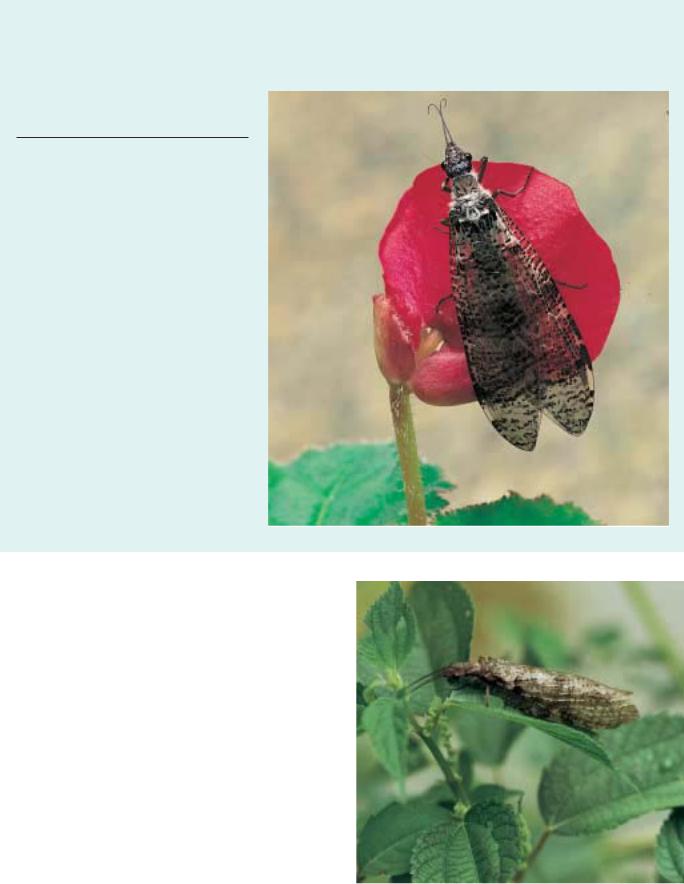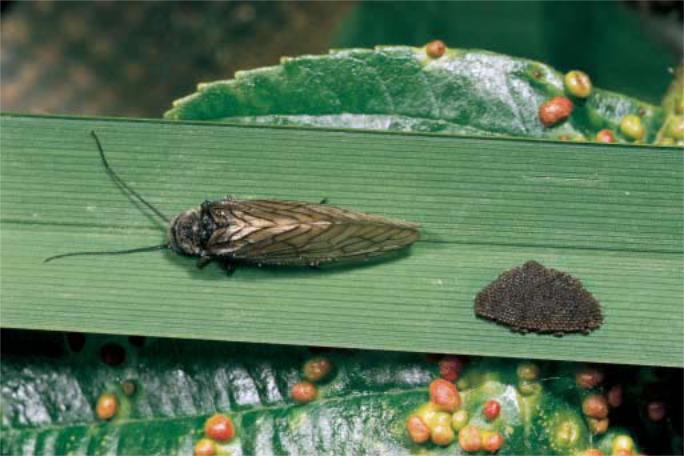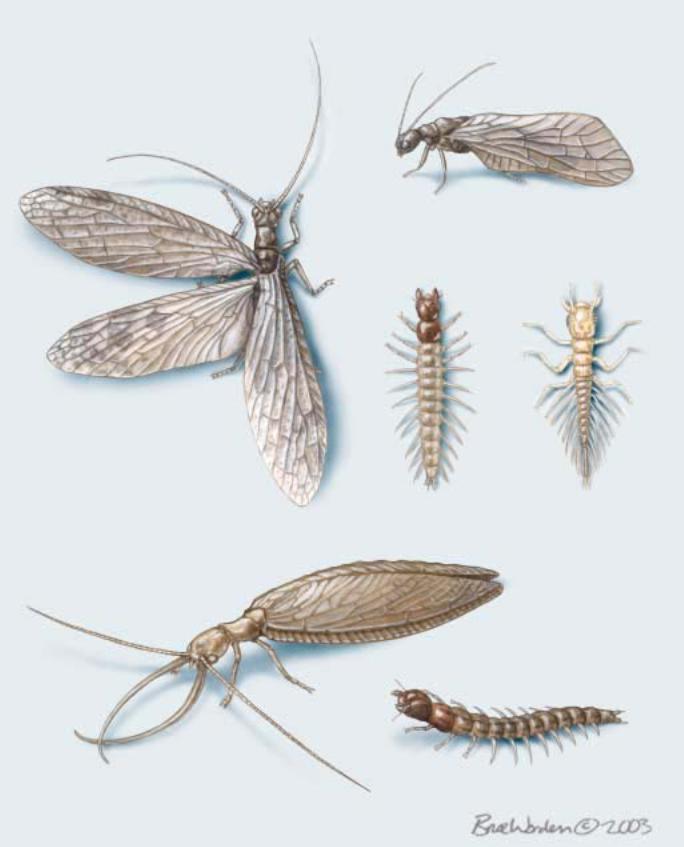
- •Contents
- •Foreword
- •How to use this book
- •Advisory boards
- •Contributing writers
- •Contributing illustrators
- •What is an insect?
- •Evolution and systematics
- •Structure and function
- •Life history and reproduction
- •Ecology
- •Distribution and biogeography
- •Behavior
- •Social insects
- •Insects and humans
- •Conservation
- •Protura
- •Species accounts
- •Collembola
- •Species accounts
- •Diplura
- •Species accounts
- •Microcoryphia
- •Species accounts
- •Thysanura
- •Species accounts
- •Ephemeroptera
- •Species accounts
- •Odonata
- •Species accounts
- •Plecoptera
- •Species accounts
- •Blattodea
- •Species accounts
- •Isoptera
- •Species accounts
- •Mantodea
- •Species accounts
- •Grylloblattodea
- •Species accounts
- •Dermaptera
- •Species accounts
- •Orthoptera
- •Species accounts
- •Mantophasmatodea
- •Phasmida
- •Species accounts
- •Embioptera
- •Species accounts
- •Zoraptera
- •Species accounts
- •Psocoptera
- •Species accounts
- •Phthiraptera
- •Species accounts
- •Hemiptera
- •Species accounts
- •Thysanoptera
- •Species accounts
- •Megaloptera
- •Species accounts
- •Raphidioptera
- •Species accounts
- •Neuroptera
- •Species accounts
- •Coleoptera
- •Species accounts
- •Strepsiptera
- •Species accounts
- •Mecoptera
- •Species accounts
- •Siphonaptera
- •Species accounts
- •Diptera
- •Species accounts
- •Trichoptera
- •Species accounts
- •Lepidoptera
- •Species accounts
- •Hymenoptera
- •Species accounts
- •For further reading
- •Organizations
- •Contributors to the first edition
- •Glossary
- •Insects family list
- •A brief geologic history of animal life
- •Index

●
Megaloptera
(Dobsonflies, fishflies, and alderflies)
Class Insecta
Order Megaloptera
Number of families 2
Photo: A fishfly (Neohermes sp.) on a flower in
Washington, USA. (Photo by Steve Solum. Bruce
Coleman, Inc. Reproduced by permission.)
Evolution and systematics
The oldest known fossils of Megaloptera date from the Permian. The Megaloptera are often considered to be the most primitive group of endopterygote (with internal development of wings as imaginal discs in the larvae) insects. The order Raphidioptera constitutes their sister group, and together with Neuroptera they form the monophyletic group of the Neuropterida. Megaloptera includes only two families, Corydalidae and Sialidae (alderflies). Corydalidae, in turn, comprises two subfamilies, Corydalinae (dobsonflies and hellgrammites) and Chauliodinae (fishflies), which are considered families by some authors.
Physical characteristics
Adult alderflies range from 0.4 to 0.6 in (10–15 mm), and dobsonflies range from 1.6 to 2.4 in (40–60 mm); larvae reach a maximum length of 1 in (25 mm) and 1.2–2.6 in (30–65 mm), respectively. Adults are soft-bodied insects, black, brown, or yellowish orange to dark green in color. They possess filiform, moniliform, or pectinate antennae and large compound eyes, and they either have (Corydalidae) or lack (Sialidae) ocelli. They have two pairs of membranous wings
A fishfly (Chauliodes sp.) on leaves in Maryland, USA. (Photo by Ron Goor. Bruce Coleman, Inc. Reproduced by permission.)
Grzimek’s Animal Life Encyclopedia |
289 |

Order: Megaloptera |
Vol. 3: Insects |
An alder fly (Sialis lutaria) with a batch of eggs. (Photo by J. Markham. Bruce Coleman, Inc. Reproduced by permission.)
with a complex nervelike pattern of veins, although longitudinal veins are not branched near the wing margin. The hind wings are broader at the base than the front wings, and this enlarged anal area is kept folded like a fan at rest. Larvae are elongated, flattened, and prognathous, with chewing mouthparts. They have seven or eight lateral pairs of abdominal gills. In sialids the abdomen ends in a median unsegmented filament, whereas in corydalids it terminates in a pair of anal prolegs. Pupae have free appendages that are not fastened to the body and are not enclosed in a cocoon.
Distribution
They occur in the New World, South Africa, Madagascar, and Asian and Australian regions and are most diverse in temperate regions, with fewer species in the tropics.
restrial. Eggs can be found in masses on leaves, branches, rocks, and bridges overhanging the aquatic habitat. Pupae are found in the shoreline soil and litter adjacent to the larval habitat, and adults are found in the same general area where larvae live.
Behavior
Adults seldom are seen in large numbers because they are short-lived and secretive. Sialids are active during the warm midday hours, engage infrequently in brief flights, and can be found resting near their larval habitats with the wings held rooflike over the abdomen. Most corydalids have nocturnal habits and are attracted to light, although there are some diurnal species. Their flight is slow and irregular, but some may fly considerable distances. At rest they keep the wings flat over the abdomen.
Habitat
Larvae are aquatic, inhabiting both lentic (still water) and lotic (moving water) environments, including streams, spring seeps, rivers, lakes, ponds, swamps, and even temporarily dry streambeds. They burrow into soft substrate or in crevices or hide under stones or bark. Eggs, pupae, and adults are ter-
Feeding ecology and diet
Larvae are entirely predaceous, feeding nonselectively on a wide variety of small aquatic invertebrates, such as insect larvae, crustaceans, mollusks, and annelids. Adults apparently do not feed.
290 |
Grzimek’s Animal Life Encyclopedia |
Vol. 3: Insects
Reproductive biology
Communication between sexes before mating is known to occur in some sialids and corydalids. Corydalus species show sexual dimorphism; males have very long mandibles with which they duel with each other and prod the female. Copulation takes place in vegetation near the water. Females deposit masses of one to five layers of 200 to 3,000 eggs on objects overhanging the water, in locations protected from insolation during the hottest part of the day. After opening the egg with an egg burster, the larvae drop to the water after hatching, where they undergo 10 to 12 molts. Fully grown larvae leave the water and pupate in an unlined chamber in the soil or litter. Adults usually emerge from late spring to midsummer. Life cycles range from one to five years.
Conservation status
About 300 species of megalopterans have been described, none of which is listed by the IUCN. Some species with re-
Order: Megaloptera
stricted distributions in small rivers and streams probably are sensitive to deforestation, pollution, and eutrophication (involving depletion of oxygen that is normally taken from the water by aquatic larvae) and could be potential candidates for conservation programs.
Significance to humans
Larvae are important predators in aquatic food chains. Some species are economically important as trout food, and their larvae are used as fish bait (i.e., Archichauliodes diversus from New Zealand). In the Japanese tradition, dried larvae of some dobsonflies are believed to be a remedy for emotional problems in children.
Grzimek’s Animal Life Encyclopedia |
291 |

1
2
3
4
5
6
1. Alderfly (Sialis lutaria) adult; 2. Dobsonfly (Archichauliodes diversus) adult; 3. Black creeper (A. diversus larva); 4. S. lutaria larva; 5. Eastern dobsonfly (Corydalus cornutus adult); 6. C. cornutus larva. (Illustration by Bruce Worden)
292 |
Grzimek’s Animal Life Encyclopedia |
